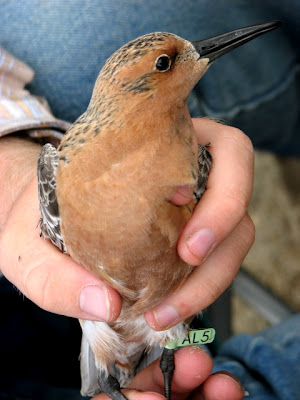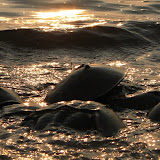Victor Ayala is a Marine Biologist from the Autonomous University of Baja California Sur. He works with shorebirds in the north of Baja California Sur, Mexico, with another great people. He is here to lead cannon netting for use back in Mexico.
Mike Boyd is a biologist for the Long Point Waterfowl and Wetlands Research Fund at Long Point Ontario. He is here to receive training in cannon-netting to help with the start of his Masters project this fall on the staging ecology of Sandhill Cranes in Ontario.
Kathleen Clark, Principal Biologist, Endangered and Nongame Species Program, has worked on shorebirds in the Delaware Bay since the mid 1980's and has conducted the aerial shorebird counts for 20 years. She leads the Program's work on endangered and threatened raptors, including the bald eagle, peregrine falcon, osprey, barred owl and red-shouldered hawk; she also leads work on tiger salamanders in southern New Jersey.
Amanda Dey, PhD, leads the Shorebird Project for the NJ Division of Fish and Wildlife's Endangered and Nongame Species Program. Her doctoral thesis focused on predicting songbird occurrence relative to landscape features. She has worked on the bay since 2001, has co-lead shorebird research in South America and the Arctic, and is currently involved, with NJ Audubon and Conserve Wildlife Foundation of NJ, in development of an online system to track banded shorebirds throughout the western hemisphere.
Alice Ewing is a PhD student at the University of Melbourne – studying survival rates in several migratory shorebird species in NW Australia. She first became involved with shorebirds in 1998 with Clive Minton and the Victorian Wader Study Group. Alice is visiting NJ to assist with flag-resighting As well as enjoying anything to do with nature and the outdoors, she loves to play canoe polo.
Bruce Ferry is from Canada, rents audio visual equipment for Conferences as a full time job but watches birds as a full time obsession. Bruce was as Assistant Warden at the Broome Bird Observatory in Australia. 2007 marks the fourth visit to NJ helping the cause.
Peter Fullagar PhD is a zoologist. He worked with CSIRO Wildlife Research for 30 years. His interests centre on waterfowl and seabirds but also include shorebirds. Now retired he maintains his interests with work on shearwaters and small petrels, island ecosystems and for a difference Superb Lyrebirds!
Steve Gates has been involved with the shorebird project for 7 years. He regularly takes part in project expeditions to the Canadian Arctic, Tierra del Fuego and Florida. Trained at Rutgers University he is currently an independent ecologist with an interest in conservation issues in New Jersey.
Pablo Lobera is also from the Autonomous University of Baja California Sur. His thesis was on the subject of marine birds on Isla San Jose Gulf of California and he also finds shorebirds interesting. He hopes to learn more about this group of birds and their catching method.
Clive Minton PhD from Australia is a world renowned shorebird expert, from the 1950s to the 1970s he lead the Wash Wader Ringing Group in the UK, he then moved to Australia where he has been instrumental in leading shorebird studies through the Australasian Wader Studies Group and the Victorian Wader Study Group. He has been involved in the Delaware Bay Shorebird project since it began in 1997.
Larry Niles PhD just retired as Chief of the Endangered and Nongame Species Program and now consults for the Conserve Wildlife Foundation of NJ. He co-leads the Delaware Bay Shorebird Project with Amanda Dey and has worked on the bay for over 25 years. Larry leads shorebird expeditions from the Arctic to Tierra del Fuego. Larry serves on the National Shorebird Council and Western Hemisphere Shorebird Reserve Council.
Mark Peck is a assistant curator of birds for the Royal Ontario Museum and has been working on the Delaware Bay since the beginning of the project. Mark has travelled from Tierra del Fuego to the Arctic with stopovers at all of the major staging areas. Mark extracts blood to sex birds and differentiate populations genetically and the resighting of flagged birds. Mark contributes photographs to this web blog
Jeannine Parvin works with New Jersey Audubon Society. She has been a volunteer with the program since 1999.
Bill Pitts is a Wildlife Technician with New Jersey’s Endangered and Non-game Species Program, and this is his third year on the shorebird project. He graduated from Rowan University in 2004 with a B.S. in Biology and a concentration in Environmental Science.
Humphrey Sitters PhD from the UK with the International Wader Study Group and edits the Wader Study Group Bulletin. He is also Honorary Secretary of the British Ornithologists’ Union and a Vice-President of the British Trust for Ornithology. He has taken part in shorebird expeditions throughout the world. This is his eleventh consecutive season studying the shorebird stopover in the Delaware Bay.
Philippa Sitters has grown up with a family of keen ornithologists and has taken advantage of a free year before going to university to join her father in Delaware Bay. She may soon be studying Classical history but this doesn’t stop her enthusiasm to help out in as many ways as possible.
Larissa Smith, Assistant Biologist, Endangered and Nongame Species Program, has worked on the Shorebird Project since 2003. Larissa leads the Shorebird Steward Project -- recruiting, training and coordinating protection activities by shorebird stewards and Division Conservation Officers during spring migration. Larissa coordinates the 15 beach closures on the Delaware Bay and Atlantic coasts to reduce disturbance to foraging shorebirds during the most critical period of northbound migration. Larissa also works on Bald Eagles and coordinates the bald eagle volunteer corps who tenaciously protect our state's bald eagle nesting population.
Susan Taylor works as a Senior Conservation Officer with the Department of Sustainability and Environment, Victoria, Australia. This is her fifth year as a volunteer on the program.
Dick Veitch is a retired Conservation Officer from New Zealand. In his work career he managed and participated in many endangered species recovery programmes in New Zealand and other parts of the world. He continues to be involved in wader banding in New Zealand and has participated in the Delaware Bay Shorebird Project for the past 10 years. At home he should be doing many chores but prefers to do woodturning.






































